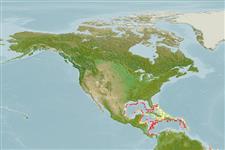>
Anguilliformes (Eels and morays) >
Congridae (Conger and garden eels) > Congrinae
Etymology: Acromycter: Greek, akros = summit, topmost + Greek, mykter, -eros = nose (Ref. 45335).
Environment: milieu / climate zone / depth range / distribution range
Écologie
marin bathydémersal; profondeur 503 - 640 m (Ref. 40789). Deep-water
Western Central Atlantic.
Taille / Poids / Âge
Maturity: Lm ? range ? - ? cm
Max length : 29.5 cm TL mâle / non sexé; (Ref. 40789)
Life cycle and mating behavior
Maturities | Reproduction | Spawnings | Egg(s) | Fecundities | Larves
Smith, D.G., 1994. Catalog of type specimens of recent fishes in the National Museum of Natural History, Smithsonian Institution, 6: Anguilliformes, Saccopharyngiformes, and Notacanthiformes (Teleostei: Elopomorpha). Smithson. Contrib. 566:50 p. (Ref. 40789)
Statut dans la liste rouge de l'IUCN (Ref. 130435)
Menace pour l'homme
Harmless
Utilisations par l'homme
Outils
Articles particuliers
Télécharger en XML
Sources Internet
Estimates based on models
Preferred temperature (Ref.
123201): 7.4 - 12.7, mean 9.4 °C (based on 9 cells).
Phylogenetic diversity index (Ref.
82804): PD
50 = 0.5312 [Uniqueness, from 0.5 = low to 2.0 = high].
Bayesian length-weight: a=0.00062 (0.00028 - 0.00136), b=3.19 (3.00 - 3.38), in cm total length, based on LWR estimates for this (Sub)family-body shape (Ref.
93245).
Niveau trophique (Ref.
69278): 3.7 ±0.5 se; based on size and trophs of closest relatives
Résilience (Ref.
120179): Milieu, temps minimum de doublement de population : 1,4 à 4,4 années (Assuming tmax>3).
Fishing Vulnerability (Ref.
59153): Low vulnerability (20 of 100).
